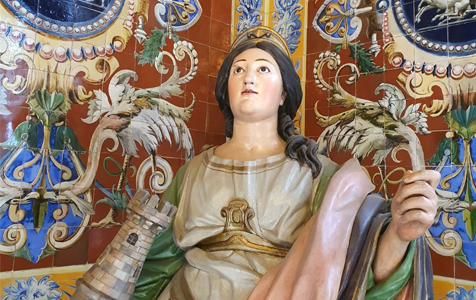SANTA BÁRBARA
(PATRON SAINT OF MINERS)

Santa Barbara has been a widely known character in popular mythology since ancient times, thanks to the numerous Greek texts, and the Latin translation of the ‘Passio de Barbara’. However, there are very few historical facts known about her: other than that, the name Barbara, is most likely of Eastern origin, very likely Egypt. The relevant time period, according to tradition, is around the 3rd or 4th centuries and most traditions agree with the following narrative.
Barbara's father was a tough man who worshipped pagan gods, and he built a large tower to guard his beautiful daughter from her many suitors, who wanted her as a wife. Santa Barbara had no intention of marrying however and consecrated herself to God. Before entering the tower, having not yet been baptized and wanting to receive the sacrament, Barbara went to a nearby pool of water and immersed herself in it three times, saying, "Barbara is baptized in the name of the Father, the Son, and the Holy Ghost." By order of her father, the tower should have had two windows, but Barbara wanted it to have three, in honor of the Holy Trinity. When her father, who was a pagan, found out that his daughter was a Christian, he decided to kill her, but she managed to escape through a miraculous hole that opened up in one of the walls of the tower. She was later re-captured and put on trial by her father, who wanted her to be punished.
The judge ordered Barbara to denounce her faith; but when that proved futile, he ordered for her to be tortured, which she was, leading to serious flesh wounds. During the night however, following a common theme in hagiographic legends - Barbara had a vision and was completely healed. The next day, the she was subjected to further even crueler torture; including having burning iron plates pressed against her flesh.
The miracles continued however, as the flames that were lit to torture her would extinguish when they got near to her body, and Barbara, who was also flogged and paraded naked around the city, returned the next morning miraculously dressed and healthy.
Finally, she was condemned to be beheaded; and her father was to be the executioner. Immediately after killing her, a ray of lightning came down from heaven and consumed the cruel father, of whom not even ashes remained.
It is said that Emperor Justin, in the 6th century, moved the martyr's relics from Egypt to Constantinople; and centuries later, the Venetians took them to Venice. The story of Barbara spread throughout Italy, probably imported during the Byzantine occupation in the 6th century and later developed during the Crusades. Traces of this cult are found in Tuscany, Umbria, and in Sabina. In Rome, according to the testimony of John Deacon (Life, IV, 89), Saint Gregory the Great, used to pray in the oratory of Santa Barbara when he was a monk.
In any case, it is true that in the 9th Century, oratorios were built in honor of Saint Barbara, of which the ‘Liber Pontificalis’ (ed. L. Duchesne, II, pp. 50, 116) bears witness in the biographies of Stephen IV (816-17) and Leo IV (847-55).
Saint Barbara is especially linked with sudden or unforeseen death (an allusion to that which her father suffered, according to legend); subsequently, her protection extended to all persons who were exposed in their work to the danger of instant death, such as gunners, carpenters, miners, and more recently firefighters. In warships the ammunition depot is often called “Santa Barbara”. The ‘Feast of Santa Barbara’ is celebrated on December 4th.
ICONOGRAPHY: The most common symbol that appears in iconography of ‘Santa Barbara’ is the peacock, which can be a generic symbol of immortality, but more likely in this case relates to a separate legend, in which it is said that the rods with which the father struck Barbara, were transformed into peacock feathers. The next most common symbol is the tower, which was to be her prison, and which featured three windows, as a symbol of the Holy Trinity, through which Santa Barbara bore witness to her faith. There are also depictions of the tower under construction; and the tower is often depicted as a small object that Barbara holds in her hands. Next to the tower, you will often find a chalice, which the saint carries in her hands as a reminder of the sacrament. The chalice is also sometimes seen with a cannon at the bottom, which had been thought to be a misinterpretation of the tower, although this hypothesis is now thought unlikely; it is more credible that the cannon alludes to the thunder that accompanied the punishment of Barbara's father.
Since the 15th century, Barbara has been a protector of gunners and miners, as a reminder, of the lightning that struck the father when he beheaded her.
Source: Chapel of Santa Barbara (ETSIME)
Currently a relic of the saint is on display in this chapel.

